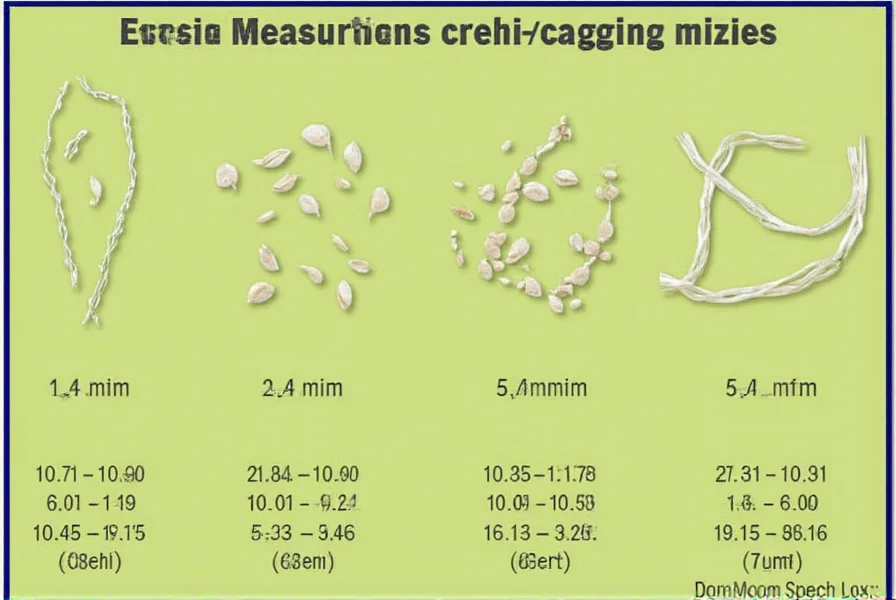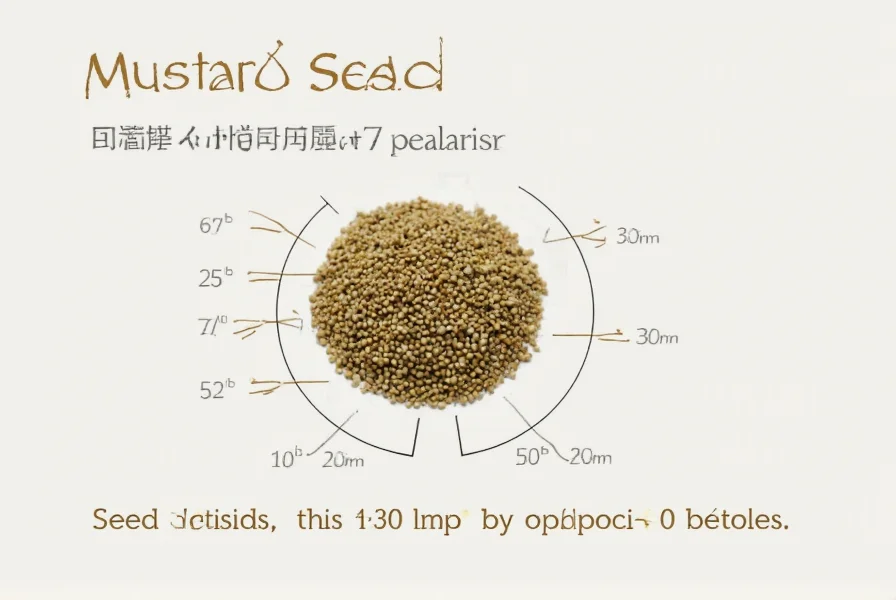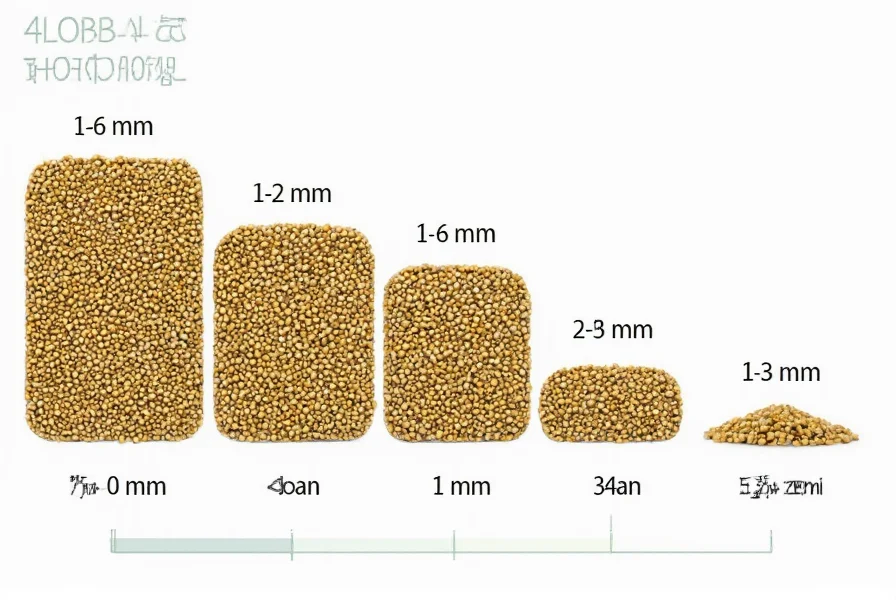Understanding the exact dimensions of mustard seeds provides valuable context for multiple applications. Whether you're planting a garden, developing food products, or simply curious about botanical measurements, knowing the specific size parameters helps make informed decisions.
Mustard Seed Varieties and Their Specific Dimensions
Not all mustard seeds are created equal when it comes to size. The three primary varieties exhibit distinct dimensional characteristics:
| Mustard Variety | Scientific Name | Average Diameter | Shape Characteristics |
|---|---|---|---|
| Yellow Mustard | Sinapis alba | 1.5-2.0 mm | Rounded, slightly larger |
| Brown Mustard | Brassica juncea | 1.0-1.5 mm | Oval, angular edges |
| Black Mustard | Brassica nigra | 1.0-1.5 mm | Smallest, nearly spherical |
These subtle differences in mustard seed size directly impact their culinary applications and agricultural handling. The larger yellow mustard seeds tend to be milder in flavor and are commonly used in American-style yellow mustard. Brown and black varieties, with their smaller size, pack more pungency and are preferred for Dijon and other specialty mustards.
Visual Comparisons for Better Understanding
Understanding abstract measurements like millimeters can be challenging without visual reference. Here's how mustard seed size compares to everyday objects:
- Average mustard seed = Size of a coarse grain of sand
- Yellow mustard seed = Slightly larger than a poppy seed (which measures about 1 mm)
- Black mustard seed = Comparable to the tip of a mechanical pencil lead (0.7-1.0 mm)
- Five mustard seeds placed side by side = Approximately 5-8 mm (about the width of a standard paperclip)

Why Mustard Seed Size Matters
The physical dimensions of mustard seeds aren't just botanical trivia—they have practical implications across several fields:
Agricultural Significance
For farmers and gardeners, mustard seed size affects planting density and germination rates. Smaller seeds like black mustard require shallower planting depths (¼ inch) compared to larger yellow varieties (½ inch). Seed size also correlates with oil content, with smaller seeds generally containing higher oil percentages—black mustard seeds yield approximately 38-40% oil by weight compared to 30-33% for yellow varieties.
Culinary Applications
In food preparation, mustard seed size influences texture and flavor release. Larger yellow seeds provide a more noticeable crunch in pickling and spice blends, while smaller black seeds dissolve more readily when ground, creating smoother mustards. Professional chefs often select specific varieties based on these size-related characteristics to achieve desired textures in finished products.
Industrial Processing
Food manufacturers consider mustard seed dimensions when designing processing equipment. Sieve sizes for cleaning and sorting operations are calibrated specifically for each variety's size range. The precise measurement of mustard seeds also affects flow properties during automated packaging, with smaller seeds requiring different handling parameters than larger varieties.
Measuring Mustard Seeds: Practical Methods
Accurately measuring mustard seed size requires appropriate tools and techniques:
- Digital Calipers: For individual seed measurement, digital calipers provide precision to 0.01 mm
- Optical Comparator: Industrial settings use this device to project magnified images for batch analysis
- Sieving Method: Passing seeds through standardized mesh sieves (ranging from 0.5 mm to 2.0 mm) provides size distribution data
- Image Analysis Software: Modern laboratories employ software that analyzes digital photographs to calculate average dimensions
For home measurement, placing 10 seeds side by side on a ruler and dividing the total length by 10 gives a reasonable approximation of average size. This practical approach helps gardeners and cooking enthusiasts understand the specific characteristics of their mustard seeds.

Common Misconceptions About Mustard Seed Size
Several myths persist about mustard seed dimensions that deserve clarification:
- Myth: All mustard seeds are the same size regardless of color
Fact: Color directly correlates with size, with yellow being largest and black smallest - Myth: Mustard seeds from the same plant will be uniform in size
Fact: Natural variation occurs within a single plant's seed production - Myth: Mustard seed size determines quality
Fact: Size relates to variety and growing conditions, not quality indicators
Understanding these distinctions helps consumers and professionals make informed choices based on actual seed characteristics rather than assumptions.
Practical Applications of Size Knowledge
Knowing the precise dimensions of mustard seeds serves multiple practical purposes:
Gardeners can optimize planting depth based on seed size, improving germination rates. Chefs select specific varieties according to desired texture in finished dishes. Food scientists use size data to develop better processing techniques. Even religious scholars reference the biblical mustard seed parable with accurate botanical understanding.
When purchasing mustard seeds, understanding size variations helps identify potential substitutions. For example, if a recipe calls for black mustard seeds (1-1.5 mm) but only brown are available (also 1-1.5 mm), they can serve as reasonable substitutes. However, substituting yellow mustard seeds (1.5-2.0 mm) would alter both texture and flavor profile significantly.
Conclusion
Mustard seed size, ranging from 1-2 millimeters depending on variety, provides essential information for agricultural, culinary, and industrial applications. The precise measurements of yellow (1.5-2.0 mm), brown (1.0-1.5 mm), and black (1.0-1.5 mm) mustard seeds directly impact their usage across multiple fields. Understanding these dimensional differences allows for better decision-making whether you're planting a garden, developing food products, or simply satisfying botanical curiosity.
How small is a mustard seed compared to other common seeds?
Mustard seeds range from 1-2 mm in diameter, making them slightly larger than poppy seeds (about 1 mm) but smaller than sesame seeds (2-3 mm). Black mustard seeds are the smallest variety at 1-1.5 mm, while yellow mustard seeds reach up to 2 mm.
Does mustard seed size affect cooking time or preparation?
Yes, mustard seed size directly impacts cooking applications. Smaller black and brown seeds release flavor more quickly when heated, while larger yellow seeds maintain their structure longer. This affects decisions about when to add seeds during cooking and how long to toast them for optimal flavor development.
Can you accurately measure mustard seed size at home?
Yes, you can approximate mustard seed size at home by lining up 10 seeds side by side on a ruler, measuring the total length in millimeters, then dividing by 10. For more precision, use a digital caliper which can measure individual seeds to 0.01 mm accuracy. This practical measurement helps gardeners and cooks understand their specific seed characteristics.
Why do different mustard seed varieties have different sizes?
Different mustard seed sizes result from botanical classification and evolutionary adaptation. Yellow mustard (Sinapis alba) belongs to a different genus than brown and black mustard (both Brassica species), leading to inherent size differences. Environmental factors like soil quality and climate also influence final seed size within each variety.
How does mustard seed size impact oil extraction yield?
Smaller mustard seeds generally yield higher oil content by weight. Black mustard seeds (1-1.5 mm) contain approximately 38-40% oil, while larger yellow mustard seeds (1.5-2.0 mm) contain 30-33% oil. The size-to-mass ratio affects processing efficiency, with smaller seeds requiring different extraction parameters than larger varieties.
Frequently Asked Questions
How small is a mustard seed compared to other common seeds?
Mustard seeds range from 1-2 mm in diameter, making them slightly larger than poppy seeds (about 1 mm) but smaller than sesame seeds (2-3 mm). Black mustard seeds are the smallest variety at 1-1.5 mm, while yellow mustard seeds reach up to 2 mm.
Does mustard seed size affect cooking time or preparation?
Yes, mustard seed size directly impacts cooking applications. Smaller black and brown seeds release flavor more quickly when heated, while larger yellow seeds maintain their structure longer. This affects decisions about when to add seeds during cooking and how long to toast them for optimal flavor development.
Can you accurately measure mustard seed size at home?
Yes, you can approximate mustard seed size at home by lining up 10 seeds side by side on a ruler, measuring the total length in millimeters, then dividing by 10. For more precision, use a digital caliper which can measure individual seeds to 0.01 mm accuracy. This practical measurement helps gardeners and cooks understand their specific seed characteristics.
Why do different mustard seed varieties have different sizes?
Different mustard seed sizes result from botanical classification and evolutionary adaptation. Yellow mustard (Sinapis alba) belongs to a different genus than brown and black mustard (both Brassica species), leading to inherent size differences. Environmental factors like soil quality and climate also influence final seed size within each variety.
How does mustard seed size impact oil extraction yield?
Smaller mustard seeds generally yield higher oil content by weight. Black mustard seeds (1-1.5 mm) contain approximately 38-40% oil, while larger yellow mustard seeds (1.5-2.0 mm) contain 30-33% oil. The size-to-mass ratio affects processing efficiency, with smaller seeds requiring different extraction parameters than larger varieties.











 浙公网安备
33010002000092号
浙公网安备
33010002000092号 浙B2-20120091-4
浙B2-20120091-4